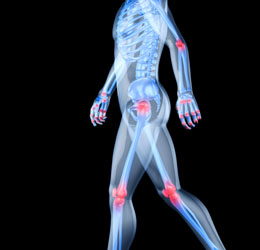People suffering from joint swelling and pain must check out the symptoms of septic arthritis. Patients affected from rheumatoid arthritis are more susceptible to the septic type. Here are a few symptoms and treatment options for the same.

Every joint cavity in our body contains synovial fluid, cellular matter, and some white blood cells. Inflammation of the joints due to bacterial infection is called septic arthritis or infectious arthritis, and is regarded as the most perilous type of acute arthritis. When bacteria or any other microorganisms reach a joint by passing through the blood stream, they cause septic arthritis. The hip and knee joints are most commonly affected, but of course the wrists and ankles are also involved. There are various factors that lead to the causes of this inflammatory joint disease.
Causes
Three factors that cause septic arthritis are bacteria, viruses, and fungi. Bacteria that lead to this disease are staphylococcus aureus, haemophilus influenzae, E. coli and pseudomonas spp. Viruses that contribute to this type of arthritis are hepatitis A, B and C, parvovirus B19, herpes virus, HIV (AIDS virus), HTLV1, adenovirus, coxsackie viruses, mumps and ebola. Fungi like histoplasma, coccidiomyces and blastomyces also result in septic arthritis.
Apart from these three factors, there are a few other causes as well, which are:
- Intravenous drug use
- Record of sexually transmitted disease
- Immunosuppressive states
- Recent steroid injection
- Joint disease
Symptoms
- High leukocyte count
- Sedimentation rate of more than 50 mm/hr
- The joint that has been affected becomes warm and swollen
- Acute pain in the affected joint, especially when you move it
- Feverish conditions which has been true for 40 to 60% cases
Those having rheumatoid arthritis, systemic connective tissue disorders, and gout, are more prone to this disease. In 10 to 20% of patients, the disease appears as polyarticular arthritis.
Diagnosis
The synovial fluid analysis should have the following parameters:
- Gram stain
- Culture
- Leukocyte count
- Differential and crystal examination
When a leukocyte count of more than 50,000 along with a polymorphonuclear leukocyte predominance is seen, septic arthritis is generally inferred. The gram stain is found positive in 10 to 80% cases. Rarely, the precipitated mucin in the synovial fluid may lead to a false positive. In 90% of non-gonococcal bacterial arthritides, the synovial fluid culture is positive.
Differential Diagnosis
- Seronegative spondyloarthropathies like psoriatic arthritis, Reiter's syndrome, ankylosing spondylitis and arthritis pertaining to inflammatory bowel disease can show up as an acute inflamed joint.
- 20% patients having untreated Lyme disease, develop chronic persistent synovitis.
- 15% of people with infective endocarditis are affected by this disease.
- Those having chronic joint disease are at a greater risk of septic arthritis, as the delay in diagnosis and start of treatment may cause a severe flare-up of the disease.
Treatment
Antibiotic Treatment
The choice of the antibiotic depends on following factors:
- Age of the patient
- Assumed source of infection
- Infection profile of patient
- Immunosuppression, like the record of diabetes
- Suspected pathogenic organism
The treatment is planned as follows:
- Initially, parenteral antibiotics are used, and later, cephalosporin or semi-synthetic penicillin is advised. If there is allergy to penicillin, then clindamycin or vancomycin is prescribed.
- Third generation cephalosporins are recommended for gram-negative bacterial infection.
- Direct inoculation of antibiotics is not essential, as it is not more useful than parenteral antibiotics.
The duration of this treatment depends on the response of the patient and the organism isolated during final culture.
Draining Infected Joints
Needle aspiration is employed for simple cases, and for complex ones like shoulder, hip or sacroiliac joints, an open arthrotomy is the initial option. After arthrotomy, the joints must be closed, and this is done by draining them with closed suction systems. Surgical treatment is considered for patients who do not respond to antibiotics or have diseases like diabetes, rheumatoid arthritis, immunosuppression or systemic symptoms. The objective of a surgical method is to remove the nonviable tissue and purulent substance to finalize the need of synovectomy.
Prosthetic Joint Infection
In a large number of cases, removing the prosthetic joint is essential. This is done by excision arthroplasty or reimplantation of the joint. There is a 4 to 6 week antibiotic therapy between the removal and re-implantation of a new prosthesis. If surgical removal is not practical, then long-term suppressive antibiotics is the choice.
Studies say that only 25 percent of patients who visit the doctor within a week can expect and hope for complete recovery. This might result in rushing through the diagnosis and treatment options, but the sooner you start the healing procedure, the better that chances of recovery.


 Every joint cavity in our body contains synovial fluid, cellular matter, and some white blood cells. Inflammation of the joints due to bacterial infection is called septic arthritis or infectious arthritis, and is regarded as the most perilous type of acute arthritis. When bacteria or any other microorganisms reach a joint by passing through the blood stream, they cause septic arthritis. The hip and knee joints are most commonly affected, but of course the wrists and ankles are also involved. There are various factors that lead to the causes of this inflammatory joint disease.
Every joint cavity in our body contains synovial fluid, cellular matter, and some white blood cells. Inflammation of the joints due to bacterial infection is called septic arthritis or infectious arthritis, and is regarded as the most perilous type of acute arthritis. When bacteria or any other microorganisms reach a joint by passing through the blood stream, they cause septic arthritis. The hip and knee joints are most commonly affected, but of course the wrists and ankles are also involved. There are various factors that lead to the causes of this inflammatory joint disease.